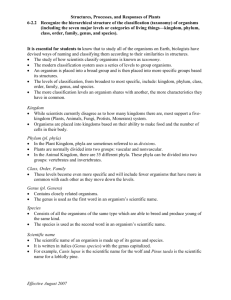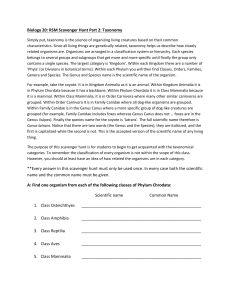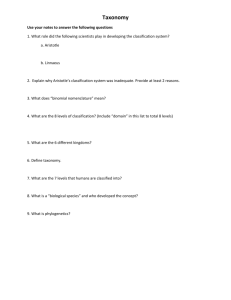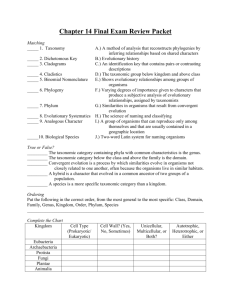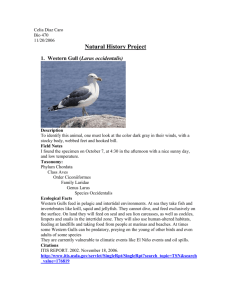Classification - Moore Public Schools
advertisement
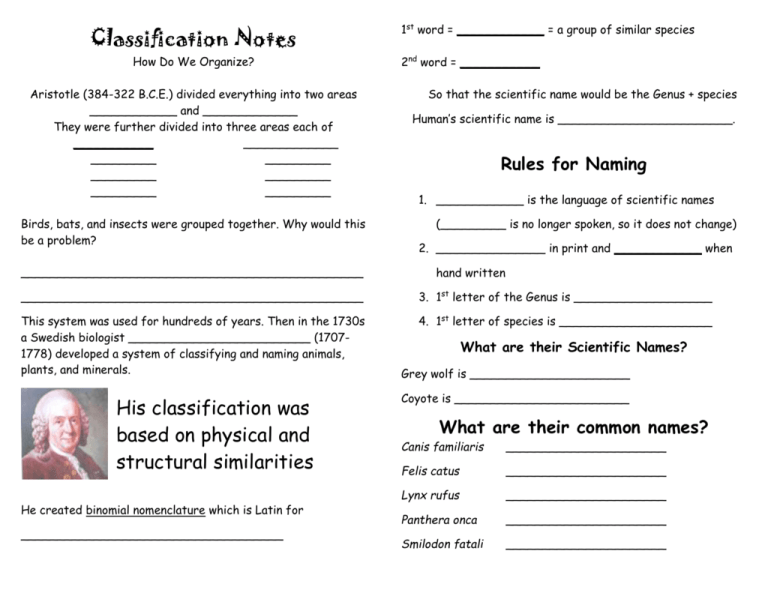
Classification Notes How Do We Organize? Aristotle (384-322 B.C.E.) divided everything into two areas ____________ and _____________ They were further divided into three areas each of ___________ _____________ _________ _________ _________ _________ _________ _________ Birds, bats, and insects were grouped together. Why would this be a problem? _______________________________________________ 1st word = ____________ = a group of similar species 2nd word = ___________ So that the scientific name would be the Genus + species Human’s scientific name is ________________________. Rules for Naming 1. ____________ is the language of scientific names (_________ is no longer spoken, so it does not change) 2. _______________ in print and ____________ when hand written _______________________________________________ 3. 1st letter of the Genus is ___________________ This system was used for hundreds of years. Then in the 1730s a Swedish biologist _________________________ (17071778) developed a system of classifying and naming animals, plants, and minerals. 4. 1st letter of species is _____________________ His classification was based on physical and structural similarities He created binomial nomenclature which is Latin for ____________________________________ What are their Scientific Names? Grey wolf is ______________________ Coyote is ________________________ What are their common names? Canis familiaris ______________________ Felis catus ______________________ Lynx rufus ______________________ Panthera onca ______________________ Smilodon fatali ______________________ Taxonomy Levels King Phillip Came Over For Good Spaghetti • Kingdom – A group of similar phyla • Phylum – A group of similar classes • Class – A group of similar orders • Order – A group of similar families • Family – A group of similar genera • Genus – A group of similar species which that have similar features and are closely related • Species – organisms that look alike and successfully interbreed Classification Vocab 1. __________________ - Grouping things that are similar 2. __________________ - The science of identifying, classifying, and naming Research online to find the genus and species names of some familiar plants and animals. organisms 3. ________________________ - Uses descriptive statements to sort and Scientific Classification identify organisms 4. __________________ - The Father of Modern Classification 5. ________________________ – Naming organisms using two-part Bird scientific names 6. __________________ - The first name of an organism (capitalized) 7. __________________ - The second name of an organism (lower case) 8. __________________ - Kingdom, Phylum, Class, Order, Family, Genus, Kingdom Species 9. __________________ - Monera, Protists, Fungi, Plants, Animals Phylum 10. __________________ – Single-celled, mostly bacteria, no nuclei 11. __________________ - Single-celled organisms divided into 3 groups: fungus-like, plant-like, and animal-like Class 12. __________________ - Multicellular organisms that absorb food from Order around them 13. __________________ - Multicellular organisms that make their own food 14. __________________ - Multicellular organisms that can move and most have a nervous system animals binomial nomenclature Carolus Linnaeus classification dichotomous key five major kingdoms fungus genus levels of classification monera plants protist species taxonomy Family Genus Species Amphibian Fungus Flower Scientific Classification Level Jaguar Squirrel Human Scientific Classification Tree Shark Level Kingdom Anamalia Anamalia Kingdom Phylum Chordata Chordate Phylum Class Mammalia Mammalia Class Order Carnivora Rodentia Order Family Felidae Scuridae Family Genus Panthera Tamiasciurus Genus Species onca hudsonicus Species Bacteria ** ** Classification Notes How Do We Organize? Aristotle (384-322 B.C.E.) divided everything into two areas ____________ and _____________ They were further divided into three areas each of ___________ _____________ _________ _________ _________ _________ _________ _________ Birds, bats, and insects were grouped together. Why would this be a problem? _______________________________________________ 1st word = ____________ = a group of similar species 2nd word = ___________ So that the scientific name would be the Genus + species Human’s scientific name is ________________________. Rules for Naming 5. ____________ is the language of scientific names (_________ is no longer spoken, so it does not change) 6. _______________ in print and ____________ when hand written _______________________________________________ 7. 1st letter of the Genus is ___________________ This system was used for hundreds of years. Then in the 1730s a Swedish biologist _________________________ (17071778) developed a system of classifying and naming animals, plants, and minerals. 8. 1st letter of species is _____________________ His classification was based on physical and structural similarities He created binomial nomenclature which is Latin for ____________________________________ What are their Scientific Names? Grey wolf is ______________________ Coyote is ________________________ What are their common names? Canis familiaris ______________________ Felis catus ______________________ Lynx rufus ______________________ Panthera onca ______________________ Smilodon fatali ______________________ Taxonomy Levels King Phillip Came Over For Good Spaghetti • Kingdom – A group of similar phyla • Phylum – A group of similar classes • Class – A group of similar orders • Order – A group of similar families • Family – A group of similar genera • Genus – A group of similar species which that have similar features and are closely related • Species – organisms that look alike and successfully interbreed Fill out the Taxonomy Level in the box and fill in the actual taxonomy for the panther on the lines.



